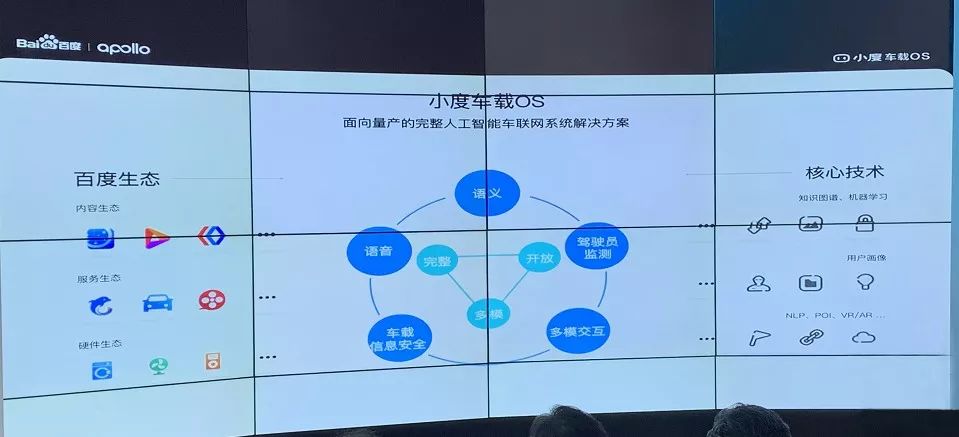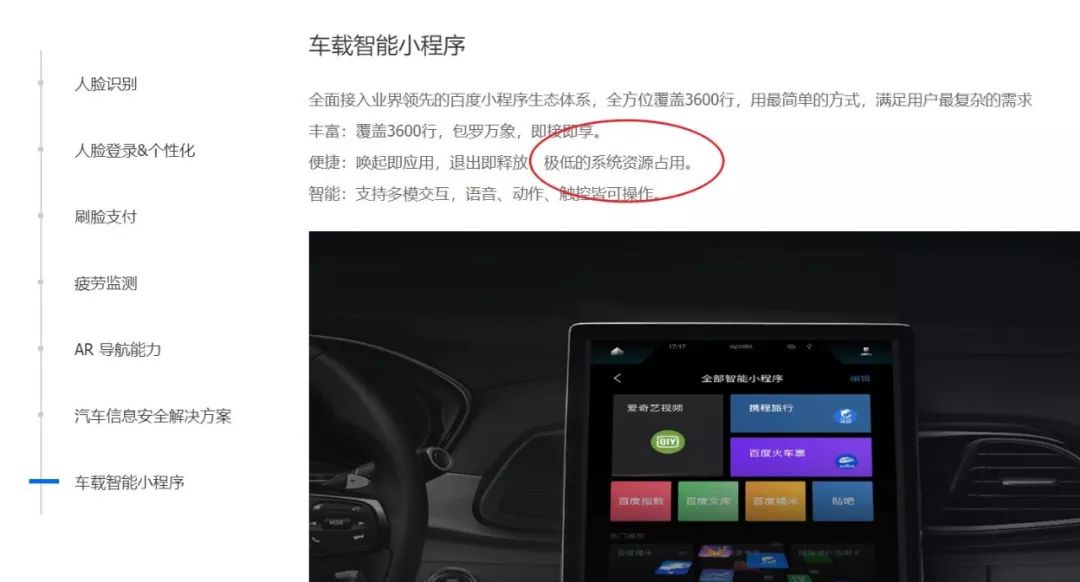On June 11th, Baidu held a press conference at CES Asia Exhibition, announcing the commercial progress of Baidu Apollo’s Xiaodu Car OS. Following Tencent’s WeChat for Car release on May 22nd, and Ali’s internet operating system Banma 3.0 on June 5th, Baidu is the last of the BAT to enter the field of connected vehicles.
Xiaodu OS has made good commercial progress in the field of connected vehicles. With a foundation of account system, OTA, and cloud services, and voice as the core interaction capability, as well as the construction of the content and service ecosystem, Xiaodu Car OS has become a competitive connected vehicle platform in China. However, overall, Baidu still has some hidden skills that will be released at the upcoming Baidu AI Developers Conference next month.
OS
Li Zhenyu, General Manager of Baidu Intelligent Driving Group, stated that as of now, over 60 auto brands have integrated the Baidu car networking function, and over 300 car models have been launched. According to Su Tan, General Manager of Baidu Car Networking Business Unit, Xiaodu Car OS has established commercial partnerships with over 60 auto brands. In our entire plan, over 500 car models will be released successively into the market in the future.
The key data disclosed by these two executives is not the more than 300 car models that have already been launched but the more than 500 car models that will follow. Why is that? “Integration of Baidu car networking function” is an ambiguous statement. For example, Does the integration of the Baidu Map Car Edition on the ES8 of NIO, a local car manufacturer, count as a significant commercial progress for Baidu’s car networking department?
In fact, from a technical point of view, the output of a single function such as map display in a car networking department is also quite limited in deepening Baidu’s understanding of “smart cars.”
The real highlight is the new Ford Explorer ST, EXEED Star Road TXL, new Haval H6 displayed at the exhibition, as well as 500 car models to be successively launched and put into mass production in the next two years, which have a common feature: integration with Xiaodu OS.
OS, which stands for Operating System, is used to load the operating system for the central control screen in a car, interconnect with the CAN bus, and manage and calculate the car’s hardware and software resources uniformly from the bottom level. This is the prerequisite for a car’s transformation into a “smart car” and the differentiating competitiveness of central control and projection solutions such as CarPlay and Android Auto.
For Baidu, the integration of Xiaodu OS in a car means that the Baidu car networking department needs to cooperate deeply with the car networking department and the electronic and electrical architecture department of the automaker to fully connect the underlying hardware and software systems, on which to build the application-level account system, OTA capability, and cloud service capability. This has a profound meaning for Baidu to further understand “smart cars”.
It can be said that without an OS, it is not an “intelligent car”. If a car is not an intelligent car, its commercial prospects in the field of car networking are very limited.
Mini Programs
The next key capability is smart mini-programs. On January 9th, 2017, WeChat mini-programs were officially launched. But in terms of product form, a car machine is a much better mini-program application scenario than a mobile phone.
The product features of mini-programs are “no download, accessible, one-use and then gone, no need to uninstall”. It solves a particularly important problem for car machines: the conflict between the slow traditional car update cycle and the rapid iteration of the internet ecology.
For example, the 2012 Model S is not as responsive as the 2018 Model 3 in terms of fluency and long-distance travel planning because the Model 3 is equipped with an updated operating system and a stronger processor.
Compared to apps, mini-programs naturally occupy less system hardware and software resources, which will fundamentally change the user experience of car machines and prolong the life cycle of car machines. In fact, Baidu Car Network has written this advantage of mini-programs into its official website.

In addition, mini-programs can more easily integrate content and services into the system, and are also friendly for migration between different systems such as Android and QNX.
On July 4th, 2018, Baidu officially launched the intelligent mini-program at the AI Developer Conference 2018. Today, Baidu’s car network intelligent mini-programs have integrated various content, services, and application ecosystems, and have been mass-produced and launched on Ford, Xingtu, and Haval models mentioned before. This also shows Baidu Car Network’s importance to mini-programs.
AI Voice
Why is voice so important? In the era of intelligent cars, the central control screen is becoming larger and larger, taking over more and more physical buttons and their corresponding functions. However, tapping, scrolling through two-level menus or even three-level menus can distract the driver in the driving scene and be very dangerous for driving safety.
This is the difference between smart speakers and smart car voice assistants in their respective specific scenes. It can be said that voice is the most important interaction mode in intelligent cars.Compared to Alibaba and Tencent, Baidu’s key differentiation advantage lies in its AI capabilities. Baidu’s “Xiaodu Car OS” semantic open platform, which combines AI with voice, has the most advanced dialogue comprehension and management capabilities, thanks to Baidu Brain UNIT technology. In fact, Baidu has independently developed its own voice and semantic modules, supporting more than five rounds of dialogue interaction and covering over 150 semantic abilities across various scenarios.
In addition to the aforementioned product forms or functional points, Baidu possesses capabilities in maps, multi-modal interaction, in-car information security, and driver monitoring. The company has implemented functions such as facial recognition, face payment, AR navigation, and smart home interconnectivity, from hardware to software, from content to services. After two years of deep cultivation, Baidu Car OS has become an important player in China’s car networking field.
However, despite all these efforts, apart from AI voice, Baidu’s car networking has not yet demonstrated any significant advantage over its competitors. At most, it is “doing the right thing” based on Baidu’s platform and resources. As for AI voice itself, compared with cloud and end voice solutions from companies like iFLYTEK and Nuance, Baidu has yet to establish an absolute advantage. If it wants to take on its competitors head-on and even gradually widen the gap, Baidu Car OS still has to continue working hard.
At today’s press conference, Xiaodu Car OS did not release any new features. In fact, Li Zhenyu revealed in his speech that Baidu Apollo will undergo a “huge product upgrade” at Baidu’s AI developer conference in July. As Baidu’s home court, the AI developer conference has always been the node for Apollo to release key updates. Looking at it today, Baidu has already secured agreements with major foreign/domestic OEMs like Mercedes-Benz, BMW, Ford, Hongqi, Haval, and Chery. Given that the car networking field is undergoing rapid change and that the car networking capabilities of BAT are evenly matched, if not homogenized, the iteration of Xiaodu Car OS is crucial.* Why can’t Baidu do the business of smart cars?

This article is a translation by ChatGPT of a Chinese report from 42HOW. If you have any questions about it, please email bd@42how.com.
